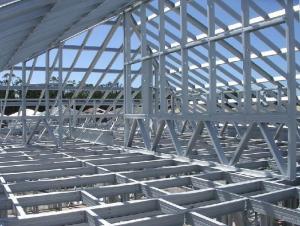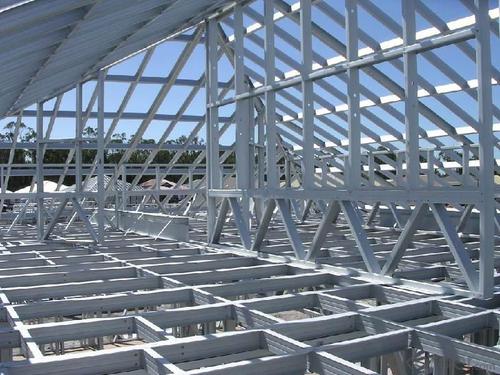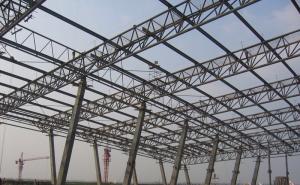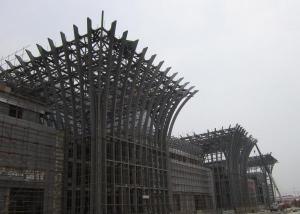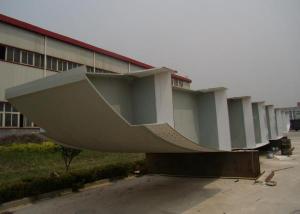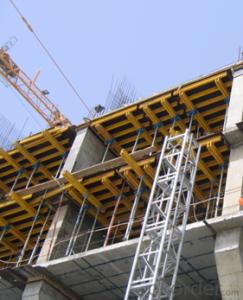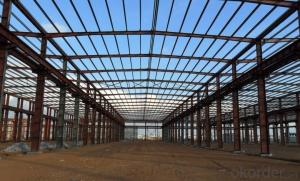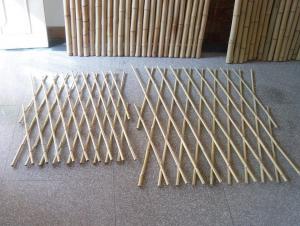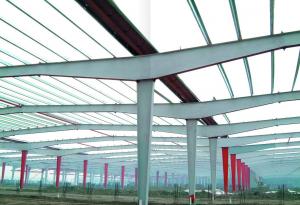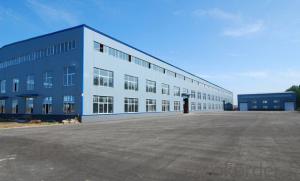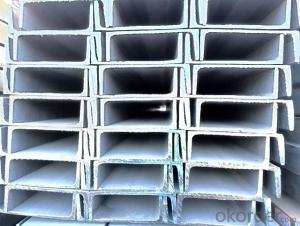Grid frame steel structure
- Loading Port:
- China Main Port
- Payment Terms:
- TT or LC
- Min Order Qty:
- -
- Supply Capability:
- -
OKorder Service Pledge
OKorder Financial Service
You Might Also Like
Product Description:
OKorder is offering steel structure at great prices with worldwide shipping. Our supplier is a world-class manufacturer of steel, with our products utilized the world over. OKorder annually supplies products to European, North American and Asian markets. We provide quotations within 24 hours of receiving an inquiry and guarantee competitive prices.
Product Applications:
1. Heavy industrial plants: relatively large span and column spacing; with a heavy duty crane or large-tonnage cranes; or plants with 2 to 3 layers cranes; as well as some high-temperature workshop should adopt steel crane beams, steel components, steel roof, steel columns, etc. up to the whole structure
2. Large span structure: the greater the span of the structure, the more significant economic benefits will have by reducing the weight of the structure
3. Towering structures and high-rise buildings: the towering structure, including high-voltage transmission line towers, substation structure, radio and television emission towers and masts, etc. These structures are mainly exposed to the wind load. Besides of its light weight and easy installation, structure steel can bring upon with more economic returns by reducing the wind load through its high-strength and smaller member section.
4. Structure under dynamic loads: As steel with good dynamic performance and toughness, so it can be used directly to crane beam bearing a greater or larger span bridge crane
5. Removable and mobile structures: Structure Steel can also apply to movable Exhibition hall and prefabricated house etc by virtue of its light weight, bolt connection, easy installation and uninstallation. In case of construction machinery, it is a must to use structure steel so as to reduce the structural weight.
6. Containers and pipes: the high-pressure pipe and pipeline, gas tank and boiler are all made of steel for the sake of its high strength and leakproofness
7. Light steel structure: light steel structures and portal frame structure combined with single angle or thin-walled structural steel with the advantages of light weight, build fast and steel saving etc., in recent years has been widely used.
8. Other buildings: Transport Corridor, trestle and various pipeline support frame, as well as blast furnaces and boilers frameworks are usually made of steel structure.
All in all, according to the reality, structure steel is widely used for high, large, heavy and light construction.
Product Advantages:
OKorder's steel structure are durable, strong, and resist corrosion.
Main Product Features:
· Premium quality
· Prompt delivery & seaworthy packing (30 days after receiving deposit)
· Corrosion resistance
· Can be recycled and reused
· Mill test certification
· Professional Service
· Competitive pricing
Product Specifications:
Specifications of steel structure
Project: Jinan west railway station
Position: The Beijing-Shanghai high speed railway (Jinan)
Steel dosage: 5000MTs
Structure type: Box, tube, bending and twisting, transverse connection
1. GB standard material
2. High Structural safety and reliability
3. The production can reach GB/JIS/ISO/ASME standard
Packaging & Delivery of steel structure
1. According to the project design and the component size, usually the main component parts are nude packing and shipped by bulk vessel. And the small parts are packed in box or suitable packages and shipped by containers.
2. This will be communicated and negotiated with buyer according to the design.
Engineering Design Software of steel structure
Tekla Structure \ AUTO CAD \ PKPM software etc
⊙Complex spatial structure project detailed design
⊙Construct 3D-model and structure analysis. ensure the accuracy of the workshop drawings
⊙Steel structure detail ,project management, automatic Shop Drawing, BOM table automatic generation system.
⊙Control the whole structure design process, we can obtain higher efficiency and better results
Technical support of steel structure
Worker | Rate of frontline workers with certificate on duty reaches 100% |
Welder | 186 welders got AWS & ASME qualification 124 welders got JIS qualification 56 welders got DNV &BV qualification |
Technical inspector | 40 inspectors with UT 2 certificate 10 inspectors with RT 2 certificate 12 inspectors with MT 2 certificate 3 inspectors with UT3 certificate |
Engineer | 21 engineers with senior title 49 engineers with medium title 70 engineers with primary title. 61 First-Class Construction Engineers 182 Second-Class Construction Engineers |
International certification | 10 engineers with International Welding engineer, 8 engineers with CWI. |
Production Flow of steel structure/steel frame
Material preparation—cutting—fitting up—welding—component correction—rust removal—paint coating—packing—to storage and transportation (each process has the relevant inspection)
Characters of Structure Steel
1. Steel is characterized by high strength, light weight, good rigidity, strong deformation capacity, so it is suitable for construction of large-span, super high and super-heavy buildings particularly;
2. It with good homogeneous and isotropic, is an ideal elastomer which perfectly fits the application of general engineering;
3. The material has good ductility and toughness, so it can have large deformation and it can well withstand dynamic loads;
4. Steel structure’s construction period is short;
5. Steel structure has high degree of industrialization and can realize-specialized production with high level of mechanization.
FAQ:
Q1: Why buy Materials & Equipment from OKorder.com?
A1: All products offered byOKorder.com are carefully selected from China's most reliable manufacturing enterprises. Through its ISO certifications, OKorder.com adheres to the highest standards and a commitment to supply chain safety and customer satisfaction.
Q2: How do we guarantee the quality of our products?
A2: We have established an advanced quality management system which conducts strict quality tests at every step, from raw materials to the final product. At the same time, we provide extensive follow-up service assurances as required.
Q3: How soon can we receive the product after purchase?
A3: Within three days of placing an order, we will begin production. The specific shipping date is dependent upon international and government factors, but is typically 7 to 10 workdays.
Images:
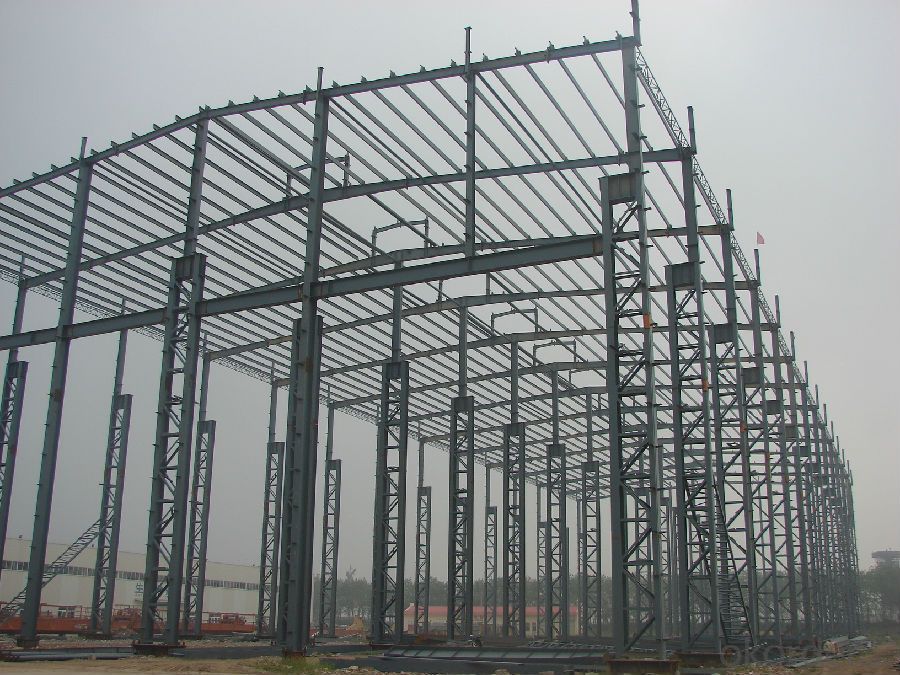
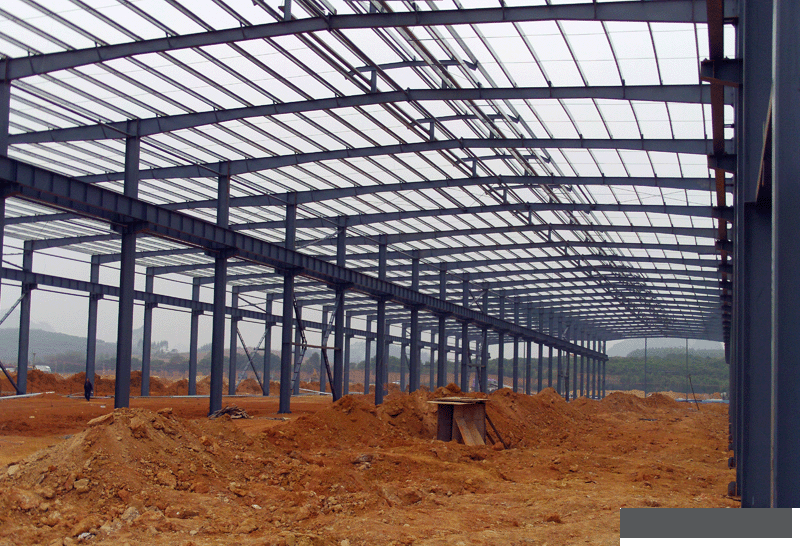
- Q: How are steel structures resistant to fire?
- Steel structures are resistant to fire due to the inherent properties of steel. Steel has a high melting point, which means it can withstand extremely high temperatures without losing its structural integrity. Additionally, steel does not burn or contribute to the spread of fire, unlike other building materials such as wood or plastics. Furthermore, steel structures can be designed with fire-resistant coatings or insulation materials that provide additional protection and prolong the time it takes for the steel to heat up. Overall, these factors make steel structures highly resistant to fire and ensure the safety of occupants during a fire incident.
- Q: What are the considerations for designing steel structures in areas with high snow accumulation?
- When it comes to designing steel structures in areas where there is a high amount of snow, there are several important factors that need to be taken into account. 1. Snow Load: The primary concern is the amount of snow that the structure will have to bear. Snow is heavy and can put a significant amount of pressure on the roof and other parts of the building. The designer must determine the snow load based on local climate data and regulations. 2. Structural Integrity: Steel structures must be able to withstand the additional weight of the snow. This requires a careful analysis of the structural members, connections, and overall design to make sure that they can support the snow load without compromising the integrity of the structure. 3. Roof Design: The design of the roof is crucial in areas with high snow accumulation. It is often preferred to have a sloped or pitched roof as this allows the snow to slide off more easily, reducing the load on the structure. The angle of the roof and the use of snow guards or other devices to prevent large amounts of snow from sliding off should be considered. 4. Drifts and Sliding: Snow can accumulate in drifts or slide down from higher areas, putting concentrated loads on certain parts of the structure. Proper design should take these factors into account and distribute the snow load evenly to avoid putting too much stress on one area. 5. Thermal Effects: Snow accumulation can insulate the roof, reducing heat transfer and potentially causing the structure to expand or experience stress. The design should consider these effects to make sure that the steel members can handle these changes without failing. 6. Building Codes and Regulations: It is essential to comply with local building codes and regulations when designing steel structures in areas with high snow accumulation. These codes provide guidelines for calculating snow loads, designing structural members, and ensuring the safety and stability of the building. 7. Maintenance and Snow Removal: Designing steel structures in areas with high snow accumulation also requires considering access for snow removal and maintenance. Features such as roof access points, adequate drainage systems, and provisions for snow removal equipment should be included in the design. In conclusion, designing steel structures in areas with high snow accumulation involves careful consideration of snow load, structural integrity, roof design, drifts and sliding, thermal effects, compliance with building codes, and maintenance requirements. By addressing these considerations, engineers can ensure that steel structures in snowy regions are safe, durable, and functional.
- Q: How is steel used in bridges?
- Due to its exceptional strength and durability, steel is widely employed in the construction of bridges. It is a versatile material that can be shaped and welded into different structural components, making it ideal for supporting heavy loads. Bridges utilize steel in several ways: 1. Structural Frames: Steel is commonly used to form the main framework of a bridge, including the support beams, columns, and trusses. These components provide the necessary strength and stability to withstand the weight of vehicles, pedestrians, and other loads. 2. Bridge Deck: Steel is also employed in constructing bridge decks, which serve as the surfaces for vehicles and pedestrians. Steel plates or grating are often placed on top of the structural framework to create a stable and durable surface. These decks can be designed with various protective coatings to prevent corrosion and enhance longevity. 3. Suspension and Cable-Stayed Bridges: Steel plays a crucial role in the construction of suspension and cable-stayed bridges. These types of bridges utilize steel cables and suspenders to support the deck, enabling longer spans and more design flexibility. The strength and flexibility of steel make it an ideal material for these bridge structures. 4. Expansion Joints: Steel expansion joints are used to accommodate the thermal expansion and contraction of bridges caused by temperature fluctuations. These joints allow the bridge to expand and contract without causing damage or structural failure. 5. Reinforcement: Concrete components of bridges often incorporate steel reinforcement bars, also known as rebar, to enhance their strength and prevent cracking or crumbling. The steel reinforcement helps distribute loads evenly and increase the overall resilience of the bridge. In conclusion, steel's high strength-to-weight ratio, durability, and versatility make it an essential material in bridge construction. Its use in various bridge components ensures the structural integrity and longevity of bridges, enabling them to safely support heavy loads and withstand the test of time.
- Q: What are the factors to consider when designing steel structures for residential buildings?
- When designing steel structures for residential buildings, several factors need to be considered. Firstly, the load-bearing capacity of the steel must be determined, taking into account the weight of the structure, as well as any potential live loads such as snow, wind, or seismic forces. Additionally, the design should consider the durability and corrosion resistance of the steel to ensure the longevity of the structure. The architectural and aesthetic requirements of the building, as well as the desired layout and functionality, must also be taken into consideration. Finally, compliance with local building codes and regulations is essential to ensure the safety and structural integrity of the residential steel building.
- Q: How are steel structures used in warehouses and storage facilities?
- Steel structures are commonly used in warehouses and storage facilities due to their strength, durability, and cost-effectiveness. Steel frames provide a sturdy and stable foundation for these structures, allowing for high ceilings and wide open spaces, which maximize storage capacity. The use of steel beams and columns ensures the ability to bear heavy loads and withstand environmental factors, such as earthquakes and harsh weather conditions. Additionally, steel structures are easily customizable and can be efficiently expanded or reconfigured to meet changing storage needs.
- Q: How are steel structures used in high-rise buildings?
- Steel structures are commonly used in high-rise buildings due to their strength, durability, and versatility. They provide the necessary support and stability required for tall structures, allowing architects to create open and flexible floor plans with large spans and minimal columns. Additionally, steel's high strength-to-weight ratio allows for lighter and more efficient construction, reducing costs and construction time. Steel structures are also highly resistant to fire, making them a safe and reliable choice for high-rise buildings.
- Q: How are steel structures used in healthcare facilities?
- Steel structures are commonly used in healthcare facilities for their strength, durability, and flexibility. They provide the necessary support for large spans and heavy loads, allowing for spacious and open floor plans. Steel structures also offer resistance to fire, earthquakes, and other natural disasters, ensuring the safety of patients and medical staff. Additionally, steel's ease of customization allows for the efficient construction of specialized areas like operating rooms, laboratories, and patient rooms. Overall, steel structures play a crucial role in creating safe and functional healthcare facilities.
- Q: What are the different types of steel columns and beams?
- There are several different types of steel columns and beams used in construction, including I-beams, H-beams, box columns, and C-channels. Each type has its own distinct shape and structural properties, allowing them to be used in various applications depending on the specific requirements of the project.
- Q: How are steel structures designed to accommodate ventilation and air circulation?
- Steel structures can be designed to accommodate ventilation and air circulation through the incorporation of openings, ducts, and louvers. These elements are strategically placed to allow the flow of air inside the structure, ensuring proper ventilation and maintaining a comfortable environment. Additionally, steel structures can also be designed with mechanical systems, such as HVAC units, to further enhance air circulation and maintain optimal air quality.
- Q: What are the considerations for designing steel canopies and shelters?
- When it comes to designing steel canopies and shelters, there are several important factors that need to be taken into consideration. These factors include the structural integrity and load capacity of the canopy or shelter, the options for materials and finishes, the aesthetic design, and any specific functional requirements. The most important aspect to consider is the structural integrity of the canopy or shelter. It must be able to withstand the various environmental loads it will face, such as wind, snow, and rain. The design of the canopy should efficiently distribute these loads to ensure stability and security. Calculating the load capacity is crucial to meet safety requirements. The options for materials and finishes should also be carefully evaluated. Steel is a popular choice due to its strength and durability. However, it is essential to choose the appropriate grade of steel based on the specific application and environmental conditions. The finish can be selected to enhance aesthetics or provide additional protection against corrosion and weathering. Aesthetic design is another important consideration for steel canopies and shelters. The design should complement the surrounding architectural style and environment. The structure's shape, color, and overall appearance should be visually appealing and harmonize with the overall design concept. Functional requirements are unique to each project and should be taken into account during the design phase. These requirements can include factors such as the size and shape of the canopy, the need for lighting or ventilation, accessibility for maintenance, and the integration of specific features or equipment. Furthermore, it is crucial to adhere to local building codes and regulations when designing steel canopies and shelters. Compliance with these codes ensures the safety and legality of the structure. In conclusion, the design of steel canopies and shelters requires careful consideration of structural integrity, material and finish options, aesthetic design, functional requirements, and compliance with local building codes. By addressing these considerations, designers can create steel canopies and shelters that are not only visually appealing but also durable, safe, and functional.
Send your message to us
Grid frame steel structure
- Loading Port:
- China Main Port
- Payment Terms:
- TT or LC
- Min Order Qty:
- -
- Supply Capability:
- -
OKorder Service Pledge
OKorder Financial Service
Similar products
Hot products
Hot Searches
Related keywords
